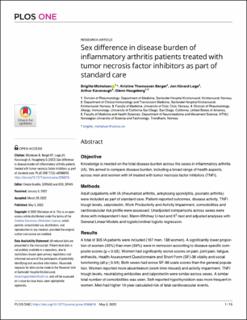| dc.contributor.author | Michelsen, Brigitte | |
| dc.contributor.author | Berget, Kristine Thomassen | |
| dc.contributor.author | Loge, Jon Håvard | |
| dc.contributor.author | Kavanaugh, Arthur | |
| dc.contributor.author | Haugeberg, Glenn | |
| dc.date.accessioned | 2023-02-22T10:40:56Z | |
| dc.date.available | 2023-02-22T10:40:56Z | |
| dc.date.created | 2022-10-11T08:49:21Z | |
| dc.date.issued | 2022 | |
| dc.identifier.citation | PLOS ONE. 2022, 17 (5), . | en_US |
| dc.identifier.issn | 1932-6203 | |
| dc.identifier.uri | https://hdl.handle.net/11250/3053164 | |
| dc.description.abstract | s Metrics Comments Media Coverage Abstract Introduction Patients and methods Results Discussion References Reader Comments Figures Abstract Objective Knowledge is needed on the total disease burden across the sexes in inflammatory arthritis (IA). We aimed to compare disease burden, including a broad range of health aspects, across men and women with IA treated with tumor necrosis factor inhibitors (TNFi). Methods Adult outpatients with IA (rheumatoid arthritis, ankylosing spondylitis, psoriatic arthritis) were included as part of standard care. Patient-reported outcomes, disease activity, TNFi trough levels, calprotectin, Work Productivity and Activity Impairment, comorbidities and cardiovascular risk profile were assessed. Unadjusted comparisons across sexes were done with independent t-test, Mann-Whitney U-test and X2-test and adjusted analyses with General Linear Models and logistic/ordinal logistic regression. Results A total of 305 IA patients were included (167 men, 138 women). A significantly lower proportion of women (45%) than men (59%) were in remission according to disease-specific composite scores (p = 0.02). Women had significantly worse scores on pain, joint pain, fatigue, enthesitis, Health Assessment Questionnaire and Short Form (SF)-36 vitality and social functioning (all p≤0.04). Both sexes had worse SF-36 scale scores than the general population. Women reported more absenteeism (work time missed) and activity impairment. TNFi trough levels, neutralizing antibodies and calprotectin were similar across sexes. A similar total number of comorbidities was seen. Self-reported hypothyroidism was more frequent in women. Men had higher 10-year calculated risk of fatal cardiovascular events. Conclusion Important differences in disease burden between men and women were seen. More attention to sex differences in the follow-up of IA patients is warranted. | en_US |
| dc.language.iso | eng | en_US |
| dc.publisher | PLOS, Public Library of Science | en_US |
| dc.rights | Navngivelse 4.0 Internasjonal | * |
| dc.rights.uri | http://creativecommons.org/licenses/by/4.0/deed.no | * |
| dc.title | Sex difference in disease burden of inflammatory arthritis patients treated with tumor necrosis factor inhibitors as part of standard care | en_US |
| dc.title.alternative | Sex difference in disease burden of inflammatory arthritis patients treated with tumor necrosis factor inhibitors as part of standard care | en_US |
| dc.type | Peer reviewed | en_US |
| dc.type | Journal article | en_US |
| dc.description.version | publishedVersion | en_US |
| dc.source.volume | 17 | en_US |
| dc.source.journal | PLOS ONE | en_US |
| dc.source.issue | 5 | en_US |
| dc.identifier.doi | 10.1371/journal.pone.0266816 | |
| dc.identifier.cristin | 2060305 | |
| cristin.ispublished | true | |
| cristin.fulltext | original | |
| cristin.qualitycode | 1 | |

